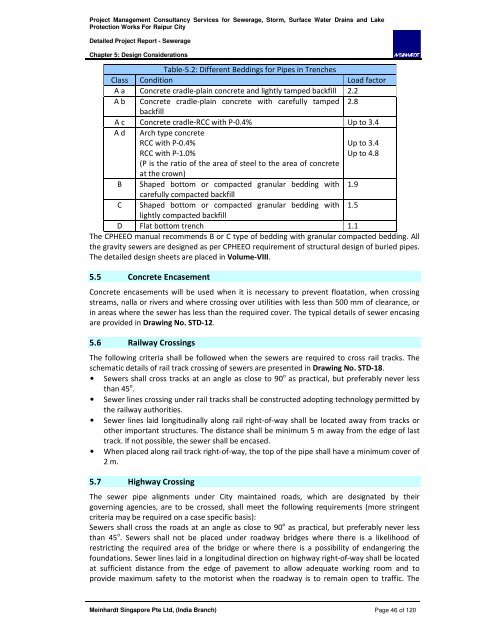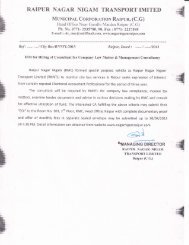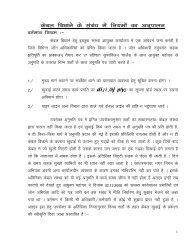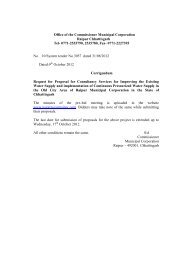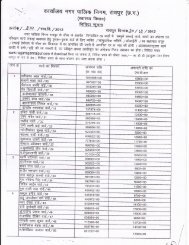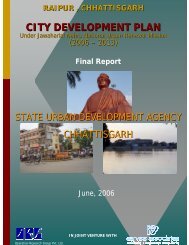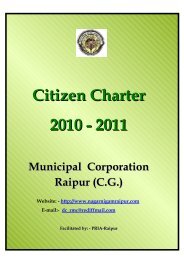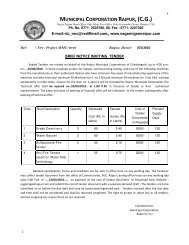Sewerage - Nagar Nigam Raipur
Sewerage - Nagar Nigam Raipur
Sewerage - Nagar Nigam Raipur
Create successful ePaper yourself
Turn your PDF publications into a flip-book with our unique Google optimized e-Paper software.
Project Management Consultancy Services for <strong>Sewerage</strong>, Storm, Surface Water Drains and Lake<br />
Protection Works For <strong>Raipur</strong> City<br />
Detailed Project Report - <strong>Sewerage</strong><br />
Chapter 5: Design Considerations<br />
Class<br />
Table-5.2: Different Beddings for Pipes in Trenches<br />
Condition Load factor<br />
A a Concrete cradle-plain concrete and lightly tamped backfill 2.2<br />
A b Concrete cradle-plain concrete with carefully tamped<br />
backfill<br />
2.8<br />
A c Concrete cradle-RCC with P-0.4% Up to 3.4<br />
A d Arch type concrete<br />
RCC with P-0.4%<br />
RCC with P-1.0%<br />
(P is the ratio of the area of steel to the area of concrete<br />
at the crown)<br />
B Shaped bottom or compacted granular bedding with<br />
carefully compacted backfill<br />
C Shaped bottom or compacted granular bedding with<br />
lightly compacted backfill<br />
Up to 3.4<br />
Up to 4.8<br />
D Flat bottom trench 1.1<br />
The CPHEEO manual recommends B or C type of bedding with granular compacted bedding. All<br />
the gravity sewers are designed as per CPHEEO requirement of structural design of buried pipes.<br />
The detailed design sheets are placed in Volume-VIII.<br />
5.5 Concrete Encasement<br />
Concrete encasements will be used when it is necessary to prevent floatation, when crossing<br />
streams, nalla or rivers and where crossing over utilities with less than 500 mm of clearance, or<br />
in areas where the sewer has less than the required cover. The typical details of sewer encasing<br />
are provided in Drawing No. STD-12.<br />
5.6 Railway Crossings<br />
The following criteria shall be followed when the sewers are required to cross rail tracks. The<br />
schematic details of rail track crossing of sewers are presented in Drawing No. STD-18.<br />
• Sewers shall cross tracks at an angle as close to 90 o as practical, but preferably never less<br />
than 45 o .<br />
• Sewer lines crossing under rail tracks shall be constructed adopting technology permitted by<br />
the railway authorities.<br />
• Sewer lines laid longitudinally along rail right-of-way shall be located away from tracks or<br />
other important structures. The distance shall be minimum 5 m away from the edge of last<br />
track. If not possible, the sewer shall be encased.<br />
• When placed along rail track right-of-way, the top of the pipe shall have a minimum cover of<br />
2 m.<br />
5.7 Highway Crossing<br />
The sewer pipe alignments under City maintained roads, which are designated by their<br />
governing agencies, are to be crossed, shall meet the following requirements (more stringent<br />
criteria may be required on a case specific basis):<br />
Sewers shall cross the roads at an angle as close to 90 o as practical, but preferably never less<br />
than 45 o . Sewers shall not be placed under roadway bridges where there is a likelihood of<br />
restricting the required area of the bridge or where there is a possibility of endangering the<br />
foundations. Sewer lines laid in a longitudinal direction on highway right-of-way shall be located<br />
at sufficient distance from the edge of pavement to allow adequate working room and to<br />
provide maximum safety to the motorist when the roadway is to remain open to traffic. The<br />
Meinhardt Singapore Pte Ltd, (India Branch) Page 46 of 120<br />
1.9<br />
1.5


